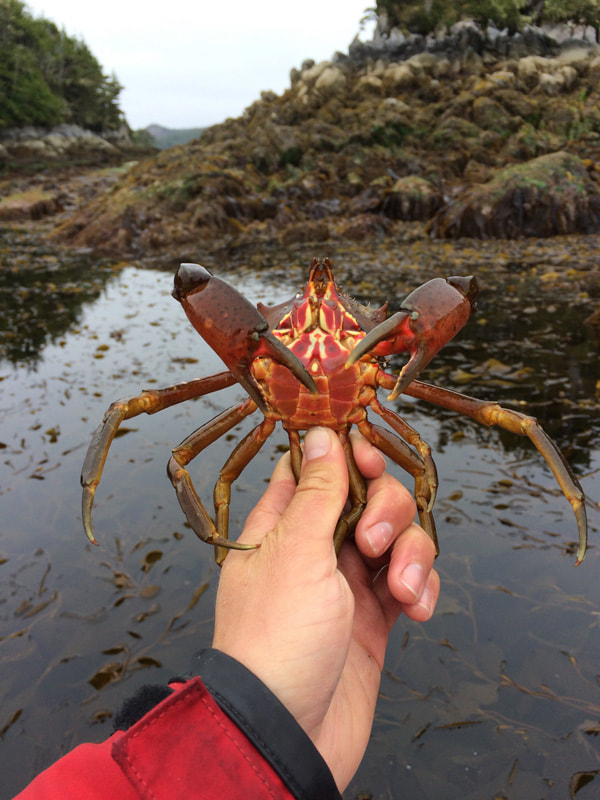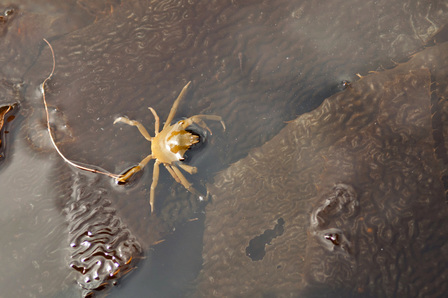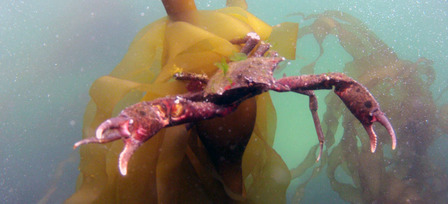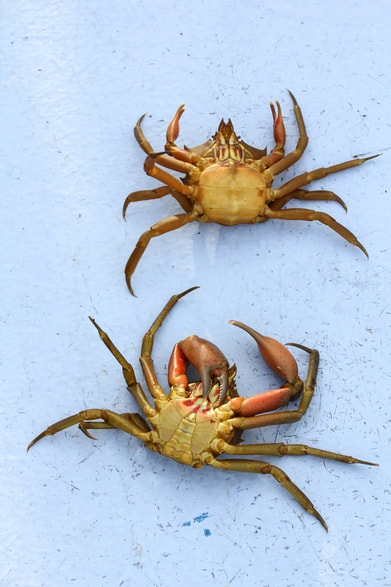Northern kelp crab, spider crab, shield back crab • Pugettia producta • Heiltsuk/Haíɫzaqv - K̓ínáxv
Yellow-green, olive green, and red northern kelp crabs. Photos by, clockwise from top left: Julian Heavyside, Rosie Child, Josh Silberg (female kelp crab above and male kelp crab below), and Jenn Burt.
Identification
This crab's carapace roughly resembles a five-pointed sheriff's badge, is smooth, and is longer than it is wide. The "points" of the carapace bear forward-curving teeth. The northern kelp crab's legs are long and end in sharp points, which it uses to cling to surfaces. The dorsal (back) colour of this crab ranges from yellowy-green to red, and the ventral (underside) colour is reddish or yellowish. The carapace gets to 9 cm wide.
Habitat & Range
This species is commonly found on pilings and hidden within kelp beds, particularly bull kelp. It is found in the intertidal zone to a depth of 75 m. Its range stretches along the west coast of North America from southern Alaska to northern Mexico.
Similar Species
The northern kelp crab are one of a handful of similar-looking species that fall under the names spider crab, decorator crab, and kelp crab. This is one of the easier ones to identify - its smooth carapace shaped like a badge separates it from the cryptic kelp crab (Pugettia richii) and the sharp-nosed crab (Scyra acutifrons), which have spiny carapaces. The graceful kelp crab (P. gracilis) has small tubercles on its carapace, and is generally smaller. Graceful kelp crab claws have blue ends with red tips. Another key distinguishing feature of the northern kelp crab is that, unlike similar kelp crabs, it does not decorate itself with algae and other organisms (though small encrusting organisms may grow on its carapace).
Intriguing Info
Northern kelp crabs use kelp beds for shelter from predators such as sea otters, as well as for food. While they generally do not decorate, they will sometimes attach pieces of kelp to little hooks just behind their rostrum (the top point of the badge shape), saving them to eat later.
While these long-legged crabs look delicate, they are actually quite strong and a pinch from their claws can be painful.
iNaturalist
https://www.inaturalist.org/taxa/49723-Pugettia-producta
This crab's carapace roughly resembles a five-pointed sheriff's badge, is smooth, and is longer than it is wide. The "points" of the carapace bear forward-curving teeth. The northern kelp crab's legs are long and end in sharp points, which it uses to cling to surfaces. The dorsal (back) colour of this crab ranges from yellowy-green to red, and the ventral (underside) colour is reddish or yellowish. The carapace gets to 9 cm wide.
Habitat & Range
This species is commonly found on pilings and hidden within kelp beds, particularly bull kelp. It is found in the intertidal zone to a depth of 75 m. Its range stretches along the west coast of North America from southern Alaska to northern Mexico.
Similar Species
The northern kelp crab are one of a handful of similar-looking species that fall under the names spider crab, decorator crab, and kelp crab. This is one of the easier ones to identify - its smooth carapace shaped like a badge separates it from the cryptic kelp crab (Pugettia richii) and the sharp-nosed crab (Scyra acutifrons), which have spiny carapaces. The graceful kelp crab (P. gracilis) has small tubercles on its carapace, and is generally smaller. Graceful kelp crab claws have blue ends with red tips. Another key distinguishing feature of the northern kelp crab is that, unlike similar kelp crabs, it does not decorate itself with algae and other organisms (though small encrusting organisms may grow on its carapace).
Intriguing Info
Northern kelp crabs use kelp beds for shelter from predators such as sea otters, as well as for food. While they generally do not decorate, they will sometimes attach pieces of kelp to little hooks just behind their rostrum (the top point of the badge shape), saving them to eat later.
While these long-legged crabs look delicate, they are actually quite strong and a pinch from their claws can be painful.
iNaturalist
https://www.inaturalist.org/taxa/49723-Pugettia-producta
References
Cowles, D. (2005). Pugettia producta (Randall, 1839). Invertebrates of the Salish Sea. Rosario Beach Marine Laboratory. Accessed 05/08/2013.
Harbo, R. M. (2011). Whelks to whales: Coastal marine life of the Pacific Northwest. Madeira Park, BC: Harbour Publishing. P. 105
Hart, J. Pugettia producta (Randall, 1839). In Klinkenberg, Brian. (Editor) 2012. E-Fauna BC: Electronic Atlas of the Fauna of British Columbia. Lab for Advanced Spatial Analysis, Department of Geography, University of British Columbia, Vancouver. Accessed 05/08/2013.
Lamb, A., and Hanby, B. (2005). Marine Life of the Pacific Northwest. Madeira Park, BC: Harbour Publishing. P. 303.
Authors and editors of page
Kelly Fretwell and Brian Starzomski (2013).
Cowles, D. (2005). Pugettia producta (Randall, 1839). Invertebrates of the Salish Sea. Rosario Beach Marine Laboratory. Accessed 05/08/2013.
Harbo, R. M. (2011). Whelks to whales: Coastal marine life of the Pacific Northwest. Madeira Park, BC: Harbour Publishing. P. 105
Hart, J. Pugettia producta (Randall, 1839). In Klinkenberg, Brian. (Editor) 2012. E-Fauna BC: Electronic Atlas of the Fauna of British Columbia. Lab for Advanced Spatial Analysis, Department of Geography, University of British Columbia, Vancouver. Accessed 05/08/2013.
Lamb, A., and Hanby, B. (2005). Marine Life of the Pacific Northwest. Madeira Park, BC: Harbour Publishing. P. 303.
Authors and editors of page
Kelly Fretwell and Brian Starzomski (2013).








